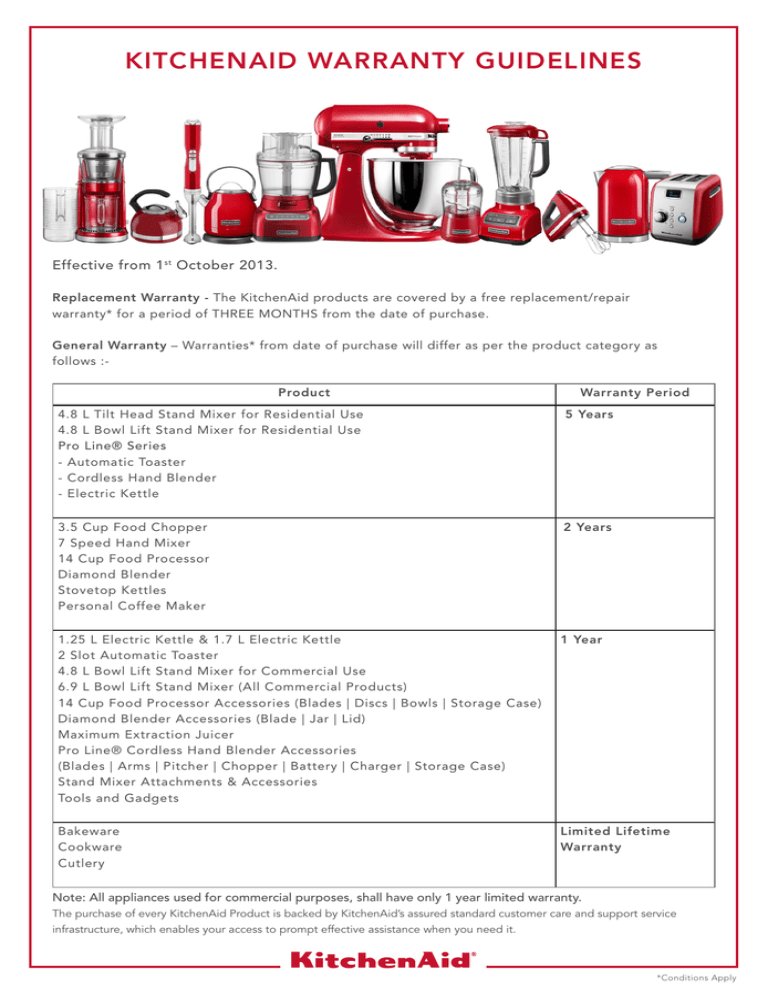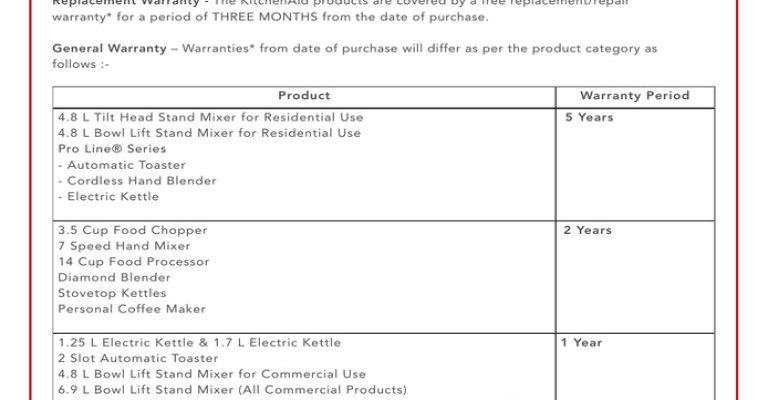
Let me break it down with an analogy. Think of your KitchenAid blender as your car. You’d want to know how long the manufacturer will help if your engine sputters, right? Appliances are the same. A warranty is basically that promise: “If this goes haywire, we’ve got your back—up to a point.”
That “point” varies between brands and even between products. For KitchenAid, the details can get a bit twisty, depending on whether you’re looking at a stand mixer, a refrigerator, or a quirky gadget. Let’s sip some coffee and untangle this together.
What Is A KitchenAid Appliance Warranty?
Here’s the thing about warranties: they’re a safety net against manufacturing slip-ups. The standard warranty for KitchenAid kitchen appliances is typically **one year** from the date you purchased your item. That means, for most gadgets—think mixers, dishwashers, refrigerators, and ovens—KitchenAid promises to fix or swap out your appliance for free if something goes wrong due to a defect in materials or craftsmanship within that year.
But what exactly does that mean? The warranty doesn’t cover accidental drops, spilled ingredients, or your cousin’s experiment with a metal spoon in the mixer. It’s strictly for problems that shouldn’t happen—like motor failures, control panels gone haywire, or doors that refuse to seal, all under normal use.
Honestly, it’s a lot like the return policy at a store. If there’s a flaw that’s not your fault, they’ll make it right. But if you try to code, reset, or sync your way out of a jam and break something, that’s where the fine print bites. That’s why it’s smart to glance at your warranty info—every KitchenAid appliance comes with a booklet or leaflet in the box, or you can find specifics online using your model code and serial number.
Standard Warranty Length For Popular KitchenAid Appliances
You might be wondering if all KitchenAid products get the exact same warranty. The answer: kind of, but not always. Here’s a breakdown of coverage for their main kitchen gadgets:
- Stand Mixers: Most classic tilt-head and bowl-lift mixers come with a 1-year full warranty.
- Refrigerators: These usually get a 1-year full warranty for parts and labor—plus extra coverage on sealed systems and compressors, sometimes up to 5 years (but usually just parts, not labor, after year one).
- Dishwashers and Ranges: Again, 1-year full warranty from purchase for both parts and labor.
- Small Kitchen Gadgets: Blenders, food processors, coffee makers, etc., typically have a 1-year warranty as well.
Let me explain with a quick story. My aunt’s old KitchenAid mixer suddenly wouldn’t start up. She checked her warranty—thankfully, she was still within that 1-year window. She called support, shared her model code, and they sent her a replacement motor. If she’d waited just a few more months, she’d be footing that repair bill herself.
The bottom line? The “standard” warranty is **one year** for basically everything, but there are important exceptions—so always check your product’s model and warranty card.
What’s Covered Under The Warranty (And What’s Not)?
Warranties sound reassuring, but the devil’s in the details. KitchenAid covers you for problems tied to manufacturing or material defects—think motors failing, electronics glitching, doors not closing, or batteries refusing to hold a charge (if your gadget has one). They’ll handle the troubleshooting, repair, or replacement with original parts.
But there’s a catch. **Here’s what the standard KitchenAid warranty won’t cover:**
- Normal wear and tear (like paint scratches or worn-out beaters)
- Damage from improper use or handling (using the wrong code to reset settings, for example)
- Accidents, drops, or power surges
- Repairs done by non-authorized service people
- Accessories or non-KitchenAid attachments
If you tamper with your appliance—maybe trying to pair your mixer with a homemade attachment, or poking around inside to fix a battery—the warranty’s void. So, if a weird error pops up and you’re tempted to open it up and troubleshoot solo, pause! You want KitchenAid to handle it so your warranty stays safe.
In my experience, it’s always smarter to call the manufacturer if something goes wrong, rather than trying to DIY and risking your coverage.
How To Make A Warranty Claim With KitchenAid
Let’s say one morning your stand mixer stops spinning or your refrigerator starts making a strange noise. Don’t panic. Making a warranty claim with KitchenAid is less painful than you’d expect, but you do need to follow some steps.
- Find your proof of purchase: This could be a receipt, order confirmation, or delivery note. You’ll need the purchase date and store details.
- Locate your model and serial number: These are usually found on a label under or inside your appliance, or sometimes in the manual.
- Contact KitchenAid support: You can call their customer service line or submit a claim online. They’ll walk you through troubleshooting steps first—it could be a simple code reset or pairing issue you can fix at home.
- Follow instructions: If your problem isn’t solved with troubleshooting, they’ll send you instructions for repair or replacement. Sometimes they’ll ship you a prepaid box for returns or schedule a technician visit (especially for large appliances).
Here’s a tip: Always write down any reference numbers or names of support reps you speak with. If a case gets complicated, you’ll be glad you did.
Extended Warranties And Protection Plans: Are They Worth It?
Now, here comes the classic upsell—KitchenAid (and retailers) will sometimes push you to buy an extended warranty or *”protection plan.”* These plans kick in after the standard 1-year warranty ends, covering repairs and sometimes accidental damage for a few more years. But are they really worth the money?
Honestly, most KitchenAid appliances are built to last. Their stand mixers, in particular, are famous for outliving their warranties by decades. But for high-end or built-in appliances (like smart refrigerators or wall ovens), repairs can get expensive fast. If you’re the type who wants total peace of mind—or you know you’re hard on your gadgets—extended plans might be helpful.
Still, it’s a gamble. Some people go years without a hiccup, while others have a big repair pop up right after the standard warranty expires. My advice: weigh the potential repair costs against the price of the plan. If a plan costs $100 but a likely repair (like a control panel) would set you back $350, it might be worth it.
Comparing KitchenAid To Other Appliance Brands
You might wonder: *Do other brands have longer (or shorter) warranties than KitchenAid?* Here’s the truth—KitchenAid’s 1-year full warranty is pretty typical in the appliance world. Brands like Whirlpool, GE, and LG offer similar 1-year warranties, sometimes with longer limited coverage for sealed systems or compressors on fridges and freezers.
Some “boutique” or ultra-premium brands offer longer full coverage—like 2 years or even more—but these are the exception, not the rule. Meanwhile, universal or third-party appliances often have weaker support, and their troubleshooting and repair networks might not be as solid.
In other words, you’re not missing out with KitchenAid. Their coverage is industry standard, and their support is known for being responsive and helpful (at least, in most users’ experience).
What To Do When Your Warranty Expires
It’s bound to happen—a year goes by, and your KitchenAid warranty runs out. What then? If a problem pops up, don’t toss your appliance out just yet.
For out-of-warranty appliances, you’ve got a few options:
- Check for recalls or service bulletins: Sometimes, even if your product is technically “out of warranty,” KitchenAid will fix it for free if there’s a known issue.
- Contact KitchenAid for repair quotes: They’ll still help diagnose and fix issues, but it’ll come out of your pocket. Ask for a repair estimate first—it might be cheaper than buying new.
- Look for certified service centers: For things like mixercode, reset, or battery replacements, only use authorized service techs to avoid further issues.
- Think about universal parts: For older gadgets, third-party (universal) parts or repairs might save money, but there’s a risk they won’t fit or perform as well as originals.
If your appliance is on its last legs, recycling or donating it (if it still works a little) is always kinder to the planet than sending it to a landfill.
Tips For Keeping Your KitchenAid Warranty Valid
Nobody wants to lose warranty coverage because of a silly mistake. Here’s how to keep things smooth:
- Register your product online: It’s optional, but it helps if you ever need to make a claim.
- Save your receipt and warranty card: Tuck these somewhere safe—KitchenAid will ask for them.
- Avoid DIY repairs: If you try to reset, pair, or swap out internal batteries on your own, you could void your protection.
- Use only KitchenAid or authorized accessories: That third-party whisk might be cool, but if it breaks your mixer, you’re on your own.
- Follow cleaning and maintenance tips: A little TLC goes a long way in keeping your appliance running smoothly (and within warranty).
Let me say this: Warranties aren’t just about fixing things—they’re also a set of rules for keeping your coverage. Treat your appliances kindly, and they’ll reward you with years of service.
Closing Thoughts On KitchenAid Appliance Warranties
The standard warranty for KitchenAid kitchen appliances is, in almost every case, **one year**—a promise that they’ll take care of parts and labor if something goes wrong due to manufacturing defects. For some bigger appliances, you might get bonus coverage on compressors or sealed systems, but the magic “full warranty” number is almost always that one year.
Is it enough? Most users find it fair, given how sturdy KitchenAid products are, but it’s always smart to double-check your specific model’s paperwork. Keep your proof of purchase, don’t try to troubleshoot or tinker with major repairs on your own, and reach out to their support team at the first sign of trouble.
At the end of the day, a good warranty is like a safety net for your kitchen dreams. Take care of your appliances, watch the calendar, and don’t be afraid to ask questions. That way, your next batch of cookies (or green smoothies, or homemade pasta) will never be interrupted.
